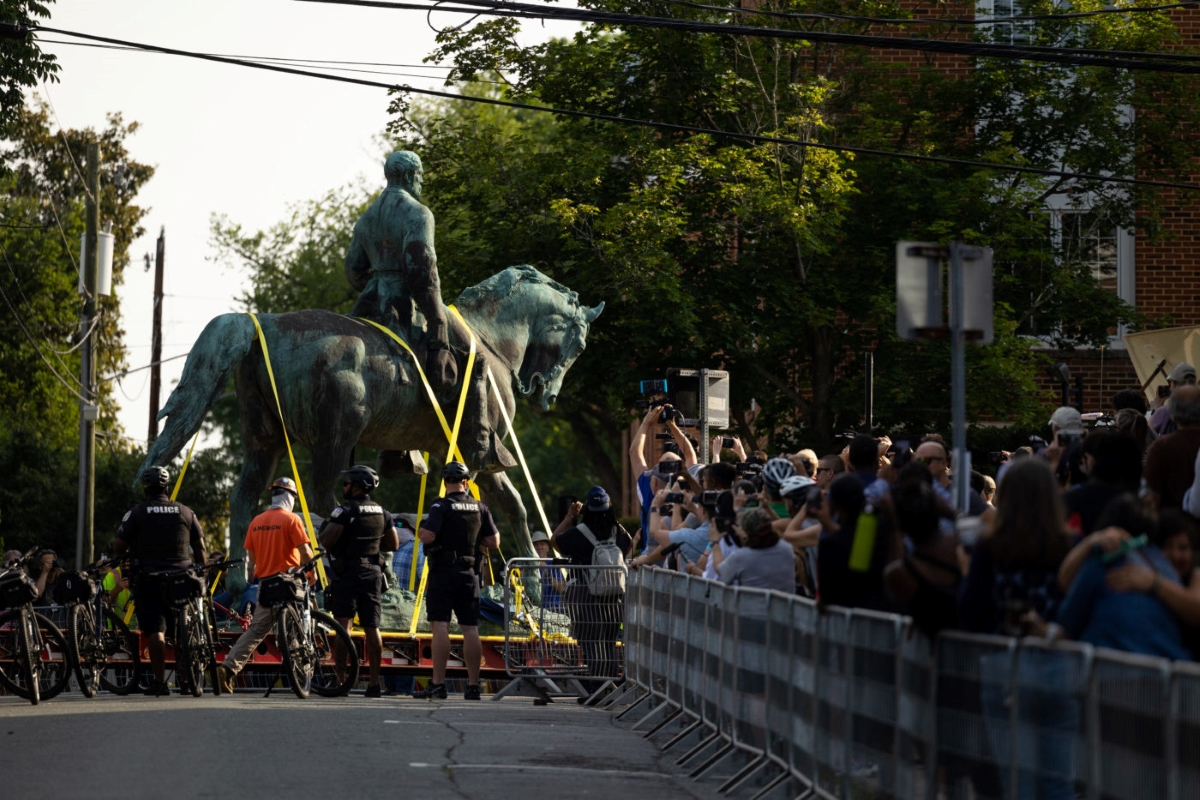There were joyful scenes at downtown Charlottesville as a confederate statue was carted away by a truck.
Towering for nearly a century, it had flared up racist protests and lethal violence.
Advertisement
People lined up the streets to witness the dismantling of the ominous statue of Gen Robert E Lee as it was taken to storage. The residents were euphoric.
The statue’s removal came more than five years after racial justice activists push that drew the attention of white supremacists and other racist groups, culminating in the violent “Unite the Right” rally in 2017.
“I’m ecstatic that we’re here now. It’s sad that it’s taken so much to get us to this point. But this is an incredible day,” said Don Gathers, a local Black activist who long advocated for the statue’s removal.
Work to remove Lee’s statue, and one of Confederate Gen. Thomas “Stonewall” Jackson shortly after, proceeded peacefully and without interruption.
It was a project held up for years by a long, winding legal fight coupled with changes in a state law that protected war memorials.
Also removed Saturday was a statue depicting Sacagawea, and explorers Meriwether Lewis and William Clark, which has been criticized for a depiction of the Native American guide and interpreter some view as subservient and weak.
Hymns at one point wafted down the street as musicians performed from the front steps of a church.
“Good atmosphere, good vibes, good energy,” said Jim Henson, a resident of a nearby community who came to witness the “historic” event.
Ralph Dixon, a 59-year-old Black man born and raised in Charlottesville, was documenting Saturday’s activities, a camera draped around his neck.
Dixon said he was brought as a schoolchild to the park where the Lee statue stood.
“All the teachers, my teachers anyway, were always talking about what a great person this was,” he said.
But his understanding was revised as he matured and he learnt the statue was erected during the Jim Crow era when Black Americans’ rights were being countermanded.
Especially after the violence of 12 August 2017, which left 32-year-old Heather Heyer dead and dozens more injured after a car plowed into a crowd of peaceful counter protesters, he said there was no reason it should stay.
A Virginia State Police helicopter assisting with the rally also crashed that weekend, killing the pilot and a trooper.
The most recent push focused on removing the Lee monument began in 2016, thanks partly to a petition started by a Black high school student, Zyahna Bryant.
After the City Council voted to remove it, a lawsuit was quickly filed, putting the plans on hold. White supremacists then began to seize on the issue.
“To the young people out there, I hope that this empowers you to speak up on the issues that matter, and to take charge in your own cities and communities,” Bryant said, standing beside Mayor Nikuyah Walker while addressing the crowd before removal work began.
“No platform for white supremacy. No platform for racism. And no platform for hate.”
Charles “Buddy” Weber, a local attorney who was a plaintiff in the lawsuit against the city, said in a phone interview that he wondered if history will view the push to remove monuments as a sincere and effective attempt at racial reconciliation.
“My personal view is that this act is not going to improve the life of anybody in the city of Charlottesville,” he said.
After the Lee statue was gone, both workers and the crowd moved to a park about two blocks away for the Jackson statue removal.
It took nearly an hour after a crane lifted the statue off its pedestal to situate the piece on a truck and secure it.
But instead of dwindling, the crowd grew, many waiting with rapt attention to see it hauled away.
Only the statues, not their stone pedestals, were removed Saturday.
They will be stored in a secure location until the City Council makes a final decision about what should be done with them.
Kristin Szakos, a former Charlottesville City Council member, said that “folks in this community have been trying to get these statues down for a hundred years.”
She added: “I think that we’re finally ready to be a community that doesn’t telegraph through our public art that we are pretty fine with white supremacy.”









